There are hundreds of thousands of contaminated sites across the country, and every solar or wind project that rises from an industrial wasteland is one that won't be built on unspoiled land, and it is unlikely that there would be public opposition to renewable energy projects on blighted land.
From Contaminated to Productive
Len Calderone for | AltEnergyMag
For years, contaminated properties, landfills, and mining sites have been a blot on our landscape, but now these areas are being used for renewable energy generation. Because of the environmental condition of these lands, they are not suitable for residential or commercial development.
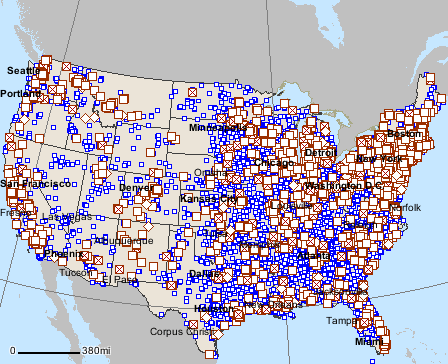
US National Library of Medicine map of toxic sites
The above map supplied by the USNLM shows the 1,673 toxic waste sites identified as a national priority for cleanup by the EPA.
There are several reasons why Superfund sites and other contaminated lands (brownfields) can be well-suited for renewable energy production. Most such sites are in remote locations. Many are large, covering thousands of acres, with the capacity to support major renewable energy facilities. These lands are ideally located close to public utilities, water and sewer, and transportation networks due to the infrastructure requirements of past land uses. Superfund sites are the federal government's program to clean up the nation's uncontrolled hazardous waste sites.
Renewable energy represents a significant, viable reuse opportunity for Superfund sites and other contaminated lands in the future with the lands converted to wind, biomass, solar and geothermal energy. Renewable energy development on contaminated land is one of the fastest growing sectors of the U.S. economy because of its potential to reduce greenhouse gas emissions, decrease dependence on foreign oil, and create economic development opportunities in communities across the country.
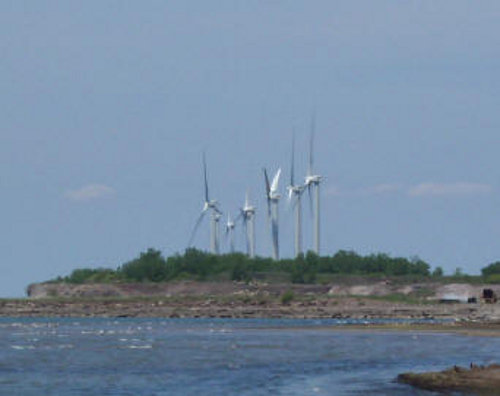
Steel Winds project
Steel production was a major industry in the City of Lackawanna, New York, but because the demand for domesticated steel declined, the plant closed in the 1980s, leaving a contaminated Superfund site. On a thirty acre portion of the former Bethlehem Steel facility, a wind energy project, known as Steel Winds was developed.
It is the largest urban wind farm in the United States, and the first to be located on a former Superfund and industrial brownfield site.
Steel Winds harnesses the winds blowing off of the Great Lakes. The Steel Winds project is in full use today, having the capacity to generate enough clean electricity to power approximately 9,000 New York homes. The transformation of this site from a forgotten industrial expanse into a progressive and renewable source of clean energy is a model for other Superfund sites.
Northwest of Detroit, Chrysler, NextEnergy and Michigan State University are exploring how biomass can be used as an alternative energy source. The ongoing research at the site is working with soybeans, corn, sunflowers, canola and switchgrass to develop biofuels like biodiesel.
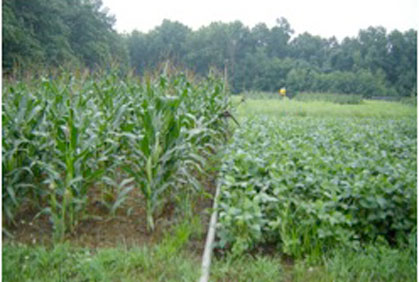
Rose Township, Michigan dump project
The 110-acre Rose Township Dump site was used for the unauthorized disposal of paint sludge and volatile organic compounds. Since the conversion, crops have been planted and harvested at the site and converted to biofuel. Tests conducted at the National Biofuels Energy Laboratory, located at NextEnergy’s headquarters in Detroit indicate that the biomass produced is of comparable quantity and quality to biomass generated from crops grown on conventional farmland. Due to the research at this site, the development of biomass and biofuels is approaching broad scale applicability at other Superfund sites across the country.
At a 40-acre facility near Sacramento, 22 solar arrays track the course of the sun, generating six megawatts of power. The solar farm is one of the largest single-site industrial installations in the United States. The partnership between Aerojet and Solar Power, Inc. has led to the development of a remarkable forty acre solar farm on the Aerojet General Corporation Superfund site.
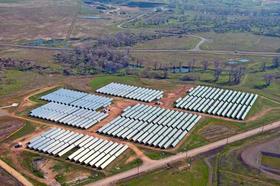
Aerojet solar farm encompasses more than 29,000 individual solar cells
Aerojet manufactured rocket engines and formulated a number of chemicals, which resulted in soil and ground water contamination. The electricity produced by the solar panels provides more than twenty percent of the energy needed to power the site’s ground water remediation program. The Aerojet solar farm is a leading example of how environmentally impaired lands can be transformed into energy-producing environmental assets.
Aerojet’s solar farm is the largest in a series of renewable energy facilities sited on current and former contaminated lands nationwide.
A full scale groundwater extraction and treatment system began operating in Port Jefferson, New York to capture and treat a contaminant plume flowing toward the Long Island Sound. Geothermal energy from the extracted groundwater is collected and used to condition air inside the new water treatment plant. The geothermal system provides higher energy efficiency and lower maintenance for building operations than a conventional heat pump, which is typically exposed to adverse weather.
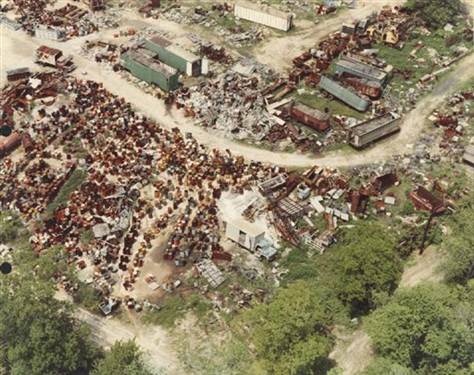
Aerial view of Lawrence Aviation Industries’ Superfund site at Port Jefferson
The site was used to manufacture titanium sheeting for the aeronautics industry, but past disposal practices and improper management of drums containing volatile organic compounds and other plant wastes resulted in a series of contaminant releases. Recovery of the site involved excavation and offsite disposal of contaminated soil, followed by construction of two groundwater extraction and treatment systems. Revitalization relies on a vertical borehole system to extract groundwater and the borehole is equipped with open-loop ground-source heat exchange system.
The average temperature of unconditioned groundwater entering the heat exchanger is 56ºF. Following heating or cooling of coils within the exchanger, the air is released at an average rate of 600 standard cubic feet per minute and blown through ductwork throughout the plant to supply warm or cool air as needed. This allows the ground below and around the treatment plant to serve as a heat source in winter and a heat sink in summer.
When most people think of renewable energy, they think of wind, solar and hydroelectric. However, there’s another source of energy that is created every day across the globe: trash. While some trash is recycled other trash is used to create energy. Naturally occurring landfill gas is used to power homes and businesses. The EPA has endorsed landfill gas as a renewable source of energy.
At some landfill sites wastes can be recycled as an alternative energy resource where landfill gas, methane, serves as an alternative energy resource that provides power for landfill operations, local businesses, schools and thousands of residences. The gas-to-energy facility at Lowry Colorado helps provide enough power to supply the needs of nearly 3,000 homes.
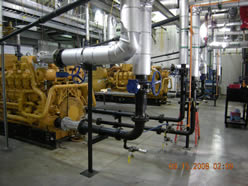
Turbine generators at the Lowry landfill gas-to-energy facility.
The facility provides benefits to the local community, as well as minimizing methane emissions that could contribute to climate change. Some of the benefits include the destroying of hazardous substances in extracted landfill gas, and reducing the emission of sulfur dioxide, nitrogen oxide, carbon dioxide, and particulate matter.
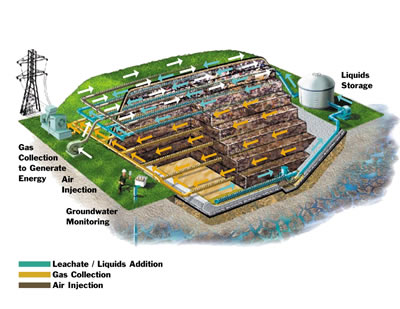
Waste Management, Inc., the country’s largest waste removal company, has 16 waste-to-energy plants, 134 recycling plants, 111 landfill gas projects and six power production plants. WM operates several bioreactor landfills that accelerate the decomposition of organic wastes in a landfill. This is accomplished by controlling the addition and removal of moisture from the waste mass, and the collection and extraction of landfill gas. The company is developing new and more effective means of distributing liquids, extracting landfill gas and tracking the progress of waste degradation.
There are hundreds of thousands of contaminated sites across the country, and every solar or wind project that rises from an industrial wasteland is one that won’t be built on unspoiled land, and it is unlikely that there would be public opposition to renewable energy projects on blighted land.
The EPA estimated that the total potential of energy from brownfields is nearly 1 million megawatts. That roughly equals the total existing U.S. electricity generating capacity.
For additional information:
1. http://www.epa.gov/oswercpa/docs/best_practices_siting_solar_photovoltaic.pdf
2. http://www.epa.gov/oswercpa/docs/contaminated_land_resuse_factsheet.pdf
3. http://www.epa.gov/oswercpa/docs/handbook_siting_repowering_projects.pdf
About LenLen contributes articles to several technology eMagazines, and has written a DIY wedding photography book, which is being published in 2013. He also writes a Op-Ed column for a local newspaper.
This article contains statements of personal opinion and comments made in good faith in the interest of the public. You should confirm all statements with the manufacturer to verify the correctness of the statements. |
 |
The content & opinions in this article are the author’s and do not necessarily represent the views of AltEnergyMag
Comments (0)
This post does not have any comments. Be the first to leave a comment below.
Featured Product

